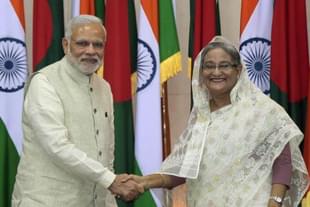Economy
Can Free-Trade Agreements Help?
Karan Bhasin and Sanya Sharma
Jul 15, 2019, 03:54 PM | Updated 03:54 PM IST
Save & read from anywhere!
Bookmark stories for easy access on any device or the Swarajya app.


There is near consensus that growth of global trade has slowed down largely because of the ongoing trade war. However, growth of world exports has been sluggish since 2011, averaging around 1.7 per cent annually. In nominal terms, this growth has been 1.5 per cent compared to a 5 per cent annual rate of growth from 2000 till 2008.
There has been a lot of talk regarding the slow growth of India’s exports over the last couple of years. This slow growth should not come as a surprise given that there has been, in general, a slowdown in global trade. The important question is if we can increase our exports at a time when global exports are growing at less than 2 per cent annually.

The answer to this question is an empathetic yes, as other nations — such as Vietnam and Cambodia — have managed to expand their exports at a higher rate than India between 2011-2018. While their exports as a percentage of total exports are lower than of India, Vietnam and Cambodia have a higher export to GDP ratio than India. The fact that other countries have managed to expand their exports despite global trade growth being slow shows how India too can expand its exports through the right policy mix.
Before going to the empirics, let’s first understand the factors that impact exports. Competitiveness is a definite factor and it depends on a host of factors such as exchange rate, domestic prices, taxation policy etc. Therefore, to be able to expand our exports it is important that our products are internationally competitive.
India has made some progress on the World Economic Forum’s (WEF’s) competitiveness index as we moved to rank 40 in 2017-18 from a rank of 71 in 2014-18. However, our labour laws combined with the high taxation rates and cost of capital are domestic policies that are a definite drag on our international competitiveness.
The government has slowly started to correct these issues as we’ve seen some progress on the labour laws front while the Budget 2019 did reduce corporate income taxes for 99.3 per cent of the firms. But we have a lot of lost ground to cover in these areas and the government seems to be working towards achieving the same.
However, there’s another important factor that influences competitiveness of products. And that is Free Trade Agreements (FTAs) or Preferential Trading Agreements (PTAs), which can help us get access to markets at terms that make our products competitive.
An FTA or a PTA is a trade agreement between two or more countries or trade blocs that primarily agree to reduce or eliminate tariff and non-tariff barriers. The main difference between an FTA and a PTA is that in a PTA there is a positive list of tariff reduction on specific tariff lines whereas in an FTA there can also be a negative list of products on which tariff cannot be reduced.
The World Bank provides us with country-level data on value of exports in constant US$ and exports as a per cent of GDP. We use the data for Vietnam, Bangladesh, Cambodia and India to arrive at the growth rate of exports for these countries from 1970 onwards. We further identified trade agreements that are currently operational for these four countries along with the year in which they came into effect.
Given that such trade agreements result in deeper market access and lower import tariffs, they should have a positive impact on the growth of exports once they come into effect.

This is reflected in the average growth rate of exports for all the countries. As expected, the growth rate of exports is higher for the years when such agreements came into effect. The growth rate continues to be high for the subsequent year after the agreement. This trend is true for all countries except for Vietnam and a major reason behind this could be the fact that at least four of trade agreements for Vietnam came into effect post 2011.

The evidence from an average change in exports as a percentage of GDP corroborates with the above findings and it demonstrates how trade agreements have a positive impact on exports. As far as impact of trade agreements on current account is concerned, for India the current account deficit as a percentage of GDP was marginally lower on an average for the years when trade agreements came into effect compared to other years.
It is worth highlighting that India’s share of global exports is at 2 per cent and exports contribution towards our GDP is 19.6 per cent. Therefore, there is significant scope to improve our exports by making them competitive.
While we address issues related to labour laws, domestic taxation and cost of capital, we should simultaneously and proactively look at signing such trade agreements with developed economies. An example of the impact of FTAs was mentioned in a recent article where one of the authors highlighted how Bangladesh has duty-free access for its ready-made garments to European Union (EU) under the Generalized Scheme of Preferences. This gives the garments sector in Bangladesh a clear competitive edge over their Indian counterparts.
While there are many factors that have an impact on exports (and imports), there is strong evidence to suggest that trade agreements positively affect exports. Global growth is slowing and protectionism is on the rise; the only solution towards increasing our exports is to get such agreements in place!
Karan Bhasin is a political economist by academic training. His areas of interest are political economy, macroeconomy, law and economics & institutional economics. Sanya Sharma is a New Delhi based trade-economist.





